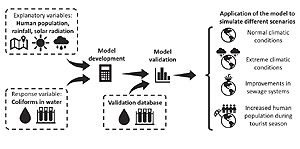
Artigo científico
This study developed, cross-validated and applied a regression-based model to predict concentrations of
faecal indicator organisms (FIOs) under different environmental conditions in the North and South bays of
Santa Catarina, South of Brazil. The model was developed using a database of FIO concentrations in
seawater sampled at 50 sites and the validation was performed using a different database by comparing 288
pairs of measured and modelled results for 15 sites. The index of agreement between the model outputs and
the FIO concentrations measured during the validation period was 66%; the mean average error was 0.43
log10 and the root mean square error was 0.58 log10 MPN.100 mL−1. These validation results
indicate that the model provides a fair representation of the FIO contamination in the bays for the
meteorological conditions under which the model was trained. The simulation of different scenarios showed
that under typical levels of resident human population in the catchments and median rainfall and solar
radiation conditions, the median FIO concentration in the bays is 0.4 MPN.100 mL−1. Under extreme
meteorological conditions, the combined effect of high rainfall and low solar radiation increased FIO
concentrations up to 5 log10 MPN.100 mL−1. The simulated scenarios also show that increases in
resident population during the summer tourist season and average rainfall concentrations do not increase
median FIO concentrations in the bays relative to periods of time with average population, possibly because
of higher bacterial die-off in the waters. The models can be an effective tool for management of human health
risks in bathing and shellfish waters impacted by sewage pollution.
